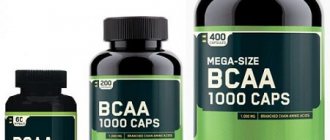What is BCAA (BCA)
The abbreviation BCA stands for one of the most useful and widely available sports supplements. It is actively used by professional bodybuilders and weightlifting enthusiasts. BCAA is used in most sports where muscle mass volumes are of great importance, since it is responsible for muscle growth. BCAAs are also noted to be beneficial for girls - the supplement allows you to quickly burn excess fat.
In fact, BCAAs are a complex of three essential essential amino acids, those that cannot be synthesized in the body on their own. You can get BCA with regular food, but sometimes using a supplement turns out to be more convenient and rational.
BCAAs composition and release forms
In sports nutrition stores, this useful supplement can be found in two main forms of release - powder and capsules. Both options have their advantages: capsules are more convenient to take orally, but useful powders are cheaper.
Regardless of the form, BCA additives have the same composition and properties. They contain three amino acids:
- leucine;
- isoleucine;
- valine
These three branched chain substances are responsible for building protein compounds in the body. To appreciate the role of BCAs, it is necessary to familiarize yourself with their properties in a little more detail.
Isoleucine
BCA isoleucine acts as an energy source for the body. The presence of isoleucine in the blood is especially important during intense strength exercise. If there is too little of it, then the reserves are quickly used up, at the same time the level of leucine decreases, and muscle tissue begins to break down. Accordingly, the athlete’s muscle volume decreases, strength indicators and endurance decrease.
Beneficial isoleucine must be present in the blood in sufficient quantities even in moments of severe hunger. At this time, there is also an active consumption of energy - with a lack of BCAA, the body again begins to receive the necessary substances from muscle tissue.
Leucine
BCA leucine is responsible for the synthesis of protein compounds. Without this substance, most proteins simply cannot form inside the body. Leucine is essential for the formation of muscle mass. Moreover, we are talking not only about the excess volumes that weightlifters are interested in, but also about the most common muscles needed by every healthy person. If there is a lack of leucine in the blood, the process of weight loss begins, the state of health worsens and there is a lack of energy.
Valin
BCAAvalin is another source of energy for the body, very important in the process of building muscles. In addition, the amount of valine in the blood is directly related to the level of the hormone serotonin, which is responsible for endurance, physical vigor and good mood. The harm from a lack of valine is a loss of strength and loss of performance - not only athletes, but also ordinary people need to monitor the level of BCA.
Why is it so important to get enough BCAA's?
BCAA are the only amino acids that are not broken down in the liver. All other amino acids are regulated in the intestines before entering the body. But the drugs go straight into the bloodstream. This means that their consumption directly affects its levels in the blood and muscle tissue. What's also interesting is that BCAAs can be oxidized to provide energy during exercise, so they can also be considered an important fuel for exercise.
Consuming bcaa before exercise can increase the amount of the substance that ends up in muscle tissue. This has many benefits, such as reducing the amount of lactic acid produced during strenuous exercise. This will improve the rate of oxidation in the muscles.
They can also improve the circulation of growth hormone in the body. Growth hormone is an anabolic hormone that causes muscle growth.
BCAAs play their most important role in muscles. Their concentration is higher in muscle cells. That's where she does her work. Bcaa is continuously released from the liver and other organs and redirected to the skeletal muscles to help normalize blood sugar levels. In addition, they may be responsible for producing 40% of the sugar released into the blood during exercise.
Due to the importance of amino acids for muscle tissue and blood sugar production, it is important to get enough of them for an effective workout. Consuming a shake that is high in carbohydrates, protein, and amino acids will trigger an insulin response that will help transport BCAAs into muscle cells. However, leucine is more important than insulin. There is one regulatory receptor in muscle cells that, when stimulated by insulin, triggers protein synthesis. But it also depends on leucine. In other words, protein synthesis (and therefore the rate of muscle regeneration) depends on how much free leucine is available. BCAA levels decrease during exercise, making supplementation with them very important during exercise.
In order for the body to synthesize new proteins, you need to consume 1 to 4 grams of leucine per day every day. This has been confirmed by the World Health Organization. This minimum amount must be consumed for leucine to begin interacting with insulin receptors. But this is just the minimum. In fact, if you are an athlete or bodybuilder doing heavy lifting, you should take about 12 grams per day.
BCAA content in different protein sources (per 100 g of product):
How do BCAs work?
Typically, strength training is aimed at increasing mass. However, during heavy loads the reverse process often starts.
- In an effort to replenish lost energy, the body begins to break down BCAAs, turning them into glucose.
- The level of valine, isoleucine and especially leucine in the blood drops sharply.
- In order to return the balance of substances to normal levels, the body starts the process of protein breakdown, extracting BCA from it.
Thus, the training does not lead to the desired result - the volume of muscle tissue either remains unchanged or even decreases.
Taking additional BCAA for weight gain can minimize the risk of muscle loss. A significant supply of BCAAs provides the body with an accessible source of energy and prevents the destruction of protein compounds. In order to maintain energy at the proper level, the body does not have to break down protein back into amino acids; the amount of valine, leucine and isoleucine is already enough for a productive workout.
Mechanisms of action of BCAA[edit | edit code]
Let's take a closer look at the points listed above, with a thorough analysis of biochemical processes and links to research and scientific literature, to give a complete picture of the role of BCAA in sports.
BCAA as an energy substrate[edit | edit code]
Exercise increases the oxidation of BCAA [6] in order to maintain energy homeostasis by converting it into a readily available energy source, glucose. Research shows that during and after exercise in athletes, the concentration of BCAA (especially leucine) decreases; immediately after this, metabolic processes are activated that are aimed at normalizing the concentration of BCAA, that is, muscle proteins begin to break down, as the main sources for replenishing the BCAA amino acid pool. Taking additional BCAAs in the form of supplements can restore their concentration and stop the process of muscle breakdown.
In addition, recently scientists have paid special attention to the role of leucine as a source of ATP (the main energy substrate of the body). [7] The oxidation of leucine in muscle produces even more ATP molecules than the same amount of glucose. And given that the oxidation of leucine and glucose follows different paths, the athlete receives 2 powerful sources of ATP at once, that is, he restores his strength much faster.
Muscle protein synthesis[edit | edit code]
As mentioned above, BCAAs make up a third of all amino acids in muscle proteins, so they can be considered the main building material of muscles. Protein can only be synthesized if free amino acids are available, otherwise growth stops. At rest, to replenish the need for amino acids, it is enough to take protein, which is gradually absorbed from the intestines and completely satisfies metabolic needs, however, during and immediately after training, the need for amino acids increases sharply, and the amino acid pool is depleted, so there is a need for large supplies of amino acids. Thus, by taking BCAA in the form of sports nutrition, the athlete creates favorable conditions for restoring the amino acid pool and building new muscle fibers immediately after training.
BCAA as glutamine precursors[edit | edit code]
BCAA as sources of glutamine
Glutamine plays an important role in muscle growth. Glutamine is found in large quantities in muscles and other tissues, plays a regulatory role in the synthesis of all types of protein in the body, shifts the nitrogen balance to the anabolic side, increases the volume of muscle cells and increases the production of growth hormone. [8]
The increased consumption of glutamine during exercise can be covered by BCAAs, which can be converted into it directly in the muscles. [9]
Stimulation of insulin secretion, PI3K and protein synthesis[edit | edit code]
One pathway that speeds up protein synthesis (i.e. muscle growth) is the phosphatodyl-inositol 3-kinase (PI3K) pathway. PI3K regulates glucose consumption and accelerates the transport of amino acids into cells. Insulin carries out its anabolic effect precisely due to PI3K.
BCAA (leucine) can enhance insulin secretion and directly activate PI3K, thus triggering anabolism even in the absence of insulin. [10] Consuming carbohydrates and BCAA after exercise leads to a synergistic rise in insulin levels, increased cellular uptake of nutrients, and accelerated muscle growth.
Activation of mTOR accelerates protein synthesis[edit | edit code]
Activation of mTOR
mTOR
from English mammalian target of rapamycin (mTOR) is a protein that regulates cell growth and division, as well as new protein synthesis. mTOR functions as an energy sensor that is activated when ATP levels are high and blocked when ATP levels are low.
The most energy-consuming process in a cell is protein synthesis, so it requires large amounts of ATP, and in addition, building material is needed - amino acids, that is, BCAA. Research shows that the intensity of anabolic processes is regulated by mTOR, which triggers protein synthesis when there is sufficient ATP and BCAA. [11] Scientists have determined that leucine plays a key role in mTOR activation [12]
BCAA and fat burning[edit | edit code]
Taking BCAA stimulates the expression of genes for the hormone leptin in adipocytes (fat cells), via the mTOR-mediated pathway. [13] Leptin is a very complex hormone that regulates many metabolic processes, such as body weight, appetite, and fat consumption and storage.
The secretion of leptin is related to the amount of body fat, the higher the percentage of body fat, the higher the secretion of leptin and vice versa. When you go through a fat-burning cycle and diet, the amount of leptin decreases, which leads to an increase in appetite and economization of metabolic processes in order to restore or maintain energy reserves of fat. That is why some athletes can significantly reduce the calorie intake and increase the load, but body weight will not change, as the body tries to maintain homeostasis. For this reason, sometimes it is necessary to greatly restrict the diet in order to shift homeostasis from the so-called control point.
BCAA, namely leucine, helps move the control point and increase leptin secretion. BCAAs seem to deceive the body, making it think that high-calorie food is entering the body. BCAAs can suppress appetite, increase calorie expenditure by burning fat, increase metabolism, and most importantly protect muscles from destruction.
Benefits of BCAAs
Having studied the composition and role of BCA for the body, we can highlight several beneficial properties of the sports supplement. BCA complex:
- protects tissue from decay during intense physical activity;
- prevents physical damage to fibers, making training safer;
- accelerates the process of formation of protein compounds necessary for building muscles and thereby promotes accelerated weight growth;
- allows you to maintain muscle volume even during a period of rest, for example, during a temporary absence of training after an injury;
- accelerates metabolism throughout the body and helps achieve an optimal ratio of muscle and fat tissue in the human body - this explains the properties of BCAA for women;
- launches fat burning processes;
- increases overall endurance of the body, reduces fatigue;
- increases testosterone levels in the blood and reduces cortisol levels, which is especially useful for men;
- has a slight anti-inflammatory effect on muscles.
We recommend reading: Products containing large amounts of sodium: table, list
The benefits of BCAAs for men are especially pronounced, but amino acids are also used by women who want to lose weight. Sports supplements allow you to specifically burn fat without sacrificing weight and maintain an adequate supply of energy in the body.
Attention! The main benefit of BCAA supplements is that the necessary substances enter the body in their pure form. Their properties are absorbed almost instantly, so the positive effect of taking them appears immediately.
Production methods and health hazards[edit | edit code]
Amino acid production occurs in four main ways:
- Extraction from hydrolyzate
- Biosynthesis or biofermentation (amino acids are produced by mutant strains of bacteria)
- Chemical synthesis
- Enzymatic synthesis (synthesis using purified enzymes)
Chemical and enzymatic synthesis for BCAA is practically not used. Bacterial biosynthesis is widely used in food products.
Currently, BCAA's for food use are produced mainly by biofermentation. Leucine, isoleucine and valine are produced by E. coli and C. glutamicum strains through the pyruvic and aspartic acid pathway. [15] Thus, isoleucine and valine are actually by-products of the synthesis.
The biofermentation method increases the cost of amino acids by 300-400% compared to chemical hydrolysis.[16]
Poor quality raw materials.
In the process of producing food amino acids, plant sources (soybeans, grains) and animal sources (milk proteins) are used. Most often, manufacturers do not indicate the sources of raw materials. Electrodialysis and several other methods can be used to obtain amino acid hydrolyzate from food and other biological wastes, including human hair, fish, feathers, blood, meat waste, etc.[17][18][19] The use of low-quality raw materials can significantly reduce the cost of the output product. There is evidence that most Chinese BCAAs are made from waste.[20][21][22]
Extraction.
The production of BCAA by this method begins with the process of protein hydrolysis. Hydrolysis can be done enzymatically or chemically by heating the protein with acids and solvents. Amino acids are then extracted from the resulting hydrolyzate. For this purpose, centrifugation, absorption, ion exchange filtration, recrystallization, precipitation, etc. are used.[23][24][25] The fraction of amino acids with side chains (the so-called leucine fraction) is separated from soy protein and other hydrolysates quite easily because they have similar molecular size and charge.[26]
Harm to health
could be for two main reasons:
- The use of low-quality raw materials and extraction does not exclude the content of toxic compounds and contaminants in the final product.
- The biofermentation method does not exclude the content of D-isomers in the final product, the biological effect of which may be potentially undesirable.
Dosage and rules for taking BCAA
In order for the properties of amino acids to bring maximum benefit, you must follow the instructions for use of BCA and adhere to the traditional schedule of supplement use.
The daily norm of amino acids for a healthy person is up to 35 g of BCA, subject to a well-balanced diet. As for time, you need to take BCA several times a day.
- To prevent harm from weight loss, it is necessary to take beneficial supplements immediately before and during training. You also need BCAA after training - this will fill the body with energy and prevent the destruction of muscle fibers. A single dose should be approximately 8 g. It is also necessary to consume BCA in the morning, and under conditions of particularly intense stress, in the evening, shortly before bedtime.
- On days when you are not planning to train, you can limit your intake to the morning and take another serving of amino acids throughout the day to protect your muscles from breakdown. A single dosage is also about 8 g of amino acids.
In general, on days of serious physical activity, it is recommended to take the amino acid complex up to 6 times a day. On weekends, it is enough to take BCA twice a day to maintain existing results.
How to take BCA capsules
BCA amino acids in capsule form are the most popular because they are the most convenient to take. But capsules also have certain disadvantages. In particular, they are absorbed more slowly by the body.
- To ensure that the beneficial properties of amino acids enter the blood faster, it is recommended to take the capsules with plenty of water.
- A single dosage depends on the volume of the valuable substance in 1 capsule - the body should receive about 8 g of amino acids per dose.
- It is necessary to take BCAA capsules in the morning, immediately during training and shortly before going to bed.
The total amount of BCA per day should be about 35 g.
How to take BCA powder
Amino acids in powder form are absorbed by the body faster, although consuming them is not as convenient as capsules. In order to dilute the healthy mixture, you will need a spoon and a glass of water. But it’s easier to calculate the correct dosage of the powder - the volume of a standard teaspoon is about 5 g, so you need to take 1.5 teaspoons of powder at a time.
The total volume of BCAA powder per day should also be about 35 g. As in the case of capsules, take BCAA during training, after it, in the morning and before bed. Since amino acids in this form of release enter the blood very quickly, you can dilute and drink the powder literally a couple of minutes before starting classes.
When to take BCAA
Studies have shown that the greatest effectiveness from the amino acid complex is achieved by taking it:
- in the morning
. This allows you to immediately fill the body with all the amino acids necessary for vigorous activity;
- before training
. Because BCAA stops muscle breakdown, taking it before exercise reduces muscle soreness the next day;
- during training
. Amino acids fill the body with energy, promote the breakdown of fats, and significantly reduce the feeling of fatigue;
- immediately after training
. This helps reduce muscle breakdown and is important for low-calorie diets.
High efficiency is also observed when mixing BCAA with sports nutrition.
Contraindications and side effects of BCAA
When carefully studying BCAA sports supplements, their benefits become obvious. But the question remains whether the properties of amino acids can be harmful to health.
The benefits and harms of BCAAs, according to doctors, depend on the quality of the supplements and compliance with the rules of use. Most specialists in the field of sports nutrition believe that BCAs themselves cannot cause harm. This is logical, since the supplement contains only essential amino acids, which are one way or another necessary for the functioning of any organism.
However, if purchased or consumed carelessly, BCAAs still have a negative effect.
- Amino acids should not be consumed on an empty stomach. Taking BCA increases appetite, but since no food enters the stomach after the amino acids, the production of gastric juice occurs in vain. At first, this can lead to heartburn, nausea and diarrhea, and if the situation repeats regularly, it can lead to gastritis and stomach ulcers.
- For the same reason, BCAAs are not recommended for use in chronic pancreatitis, gastritis, ulcers, and severe liver and kidney diseases. Useful supplements increase the secretion of internal organs, create a certain extra load and can provoke exacerbations, which will cause harm.
We recommend reading: Sprats: benefits and harm to the body
Advice! When purchasing BCA, you must ensure that the composition of the additives is natural, without unnecessary impurities, dyes, or flavor enhancers that can cause an allergic reaction.
What products contain BCA?
BCAA amino acids cannot be produced by the body on its own, but they can be obtained not only from sports supplements. Beneficial isoleucine, valine and leucine are found in common foods, namely:
- in chicken fillet;
- in salmon;
- in lean beef;
- in chicken eggs;
- in peanuts.
However, taking a sports supplement remains preferable for the reason that the amounts of amino acids in the listed products are very small. For example, 150 g of chicken fillet contains only about 6 g of amino acids; to obtain the daily requirement of substances, you will have to boil fresh meat several times a day.
Important! Through the consumption of ordinary foods, you can obtain only the necessary minimum of BCA acids, which is sufficient for the normal functioning of the body.
To gain muscle mass or lose weight, the supply of BCAA in the blood must be increased.
BCAA in proteins
One question many people ask is should you take bza while on a balanced diet that already contains a lot of protein? Although BCAAs are found in many protein foods, supplementing with them still has specific benefits.
Even such an easily digestible protein as whey cannot quickly deliver amino acids to the muscles. The addition of pure amino acids is much more effective in this case. Once purified, they almost instantly enter the bloodstream. Although whey protein is rapidly absorbed, the metabolic response will be different.
When whey protein reaches the intestines, it will take 4 minutes to digest before the amino acids are available to the body. If you were relying on protein, you most likely won't notice its effects in time.
In other words, although you get BCAA from protein, you get it much faster from a supplement than from food, making it much more effective for your workout.
Which is better: protein or BCAAs?
Along with BCA supplements, protein mixtures or protein shakes are popular. It is believed that their properties and benefits are similar to those of BCAAs. Protein is also responsible for weight gain and fat burning processes.
However, BCA and protein cannot be considered equivalent and interchangeable. There are important differences between them.
- More than 20 amino acids are present in protein mixtures. Thus, more nutrients enter the body along with protein. But at the same time, whey proteins are absorbed more slowly—the process takes at least 40 minutes.
- BCA supplements contain only 3 essential amino acids in their pure form. Despite the fact that the composition of the supplements is a little poorer, the effect of BCAA occurs almost instantly - you can drink the product in powder or capsules directly during training, and this will be beneficial.
If you need to maintain the body's energy directly during physical activity, BCAAs will give the best effect. Protein will be more useful if you need to deliver an expanded complex of valuable substances to the body.
How to spot a fake BCAA
The benefits and harms of BCAA amino acids depend on the naturalness of the supplements. Unfortunately, you can find a lot of fake BCAs on the sports nutrition market. In order not to stumble upon a counterfeit product, first of all you need to purchase products from trusted brands - and read the composition of the complex before purchasing.
However, the quality of BCA can be assessed directly during the first dose.
- Counterfeit BCAs have a bitter taste and should not be consumed; their properties can be harmful and cause poisoning.
- Fake BCAAs in powder form, when diluted in water, form a film on the surface of the liquid, which normally should not exist.
- Small crystals of counterfeit additives dissolve poorly, leaving sediment at the bottom of the glass.
The unnaturalness of additives may be indicated by the presence of flavorings and other impurities in the composition. Most often, with their help, the manufacturer tries to hide the low-quality properties of the product.











